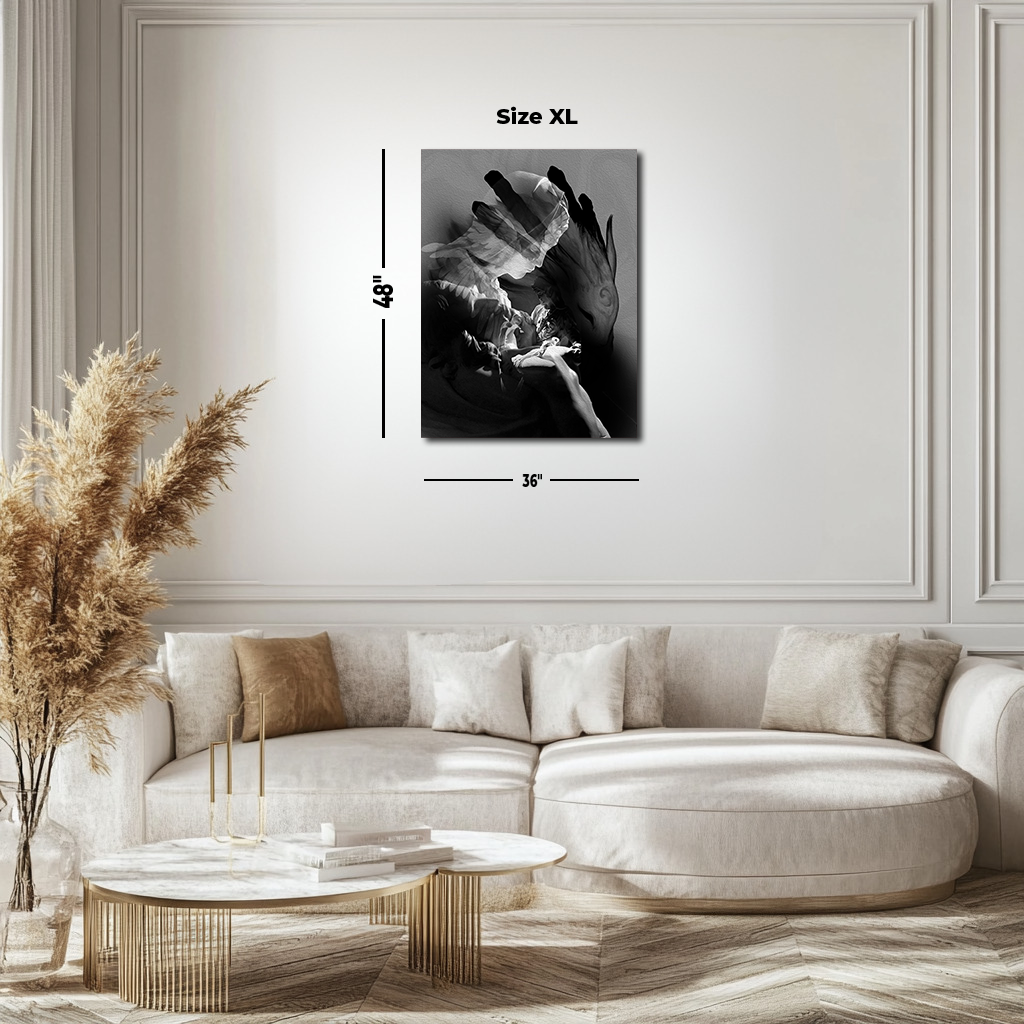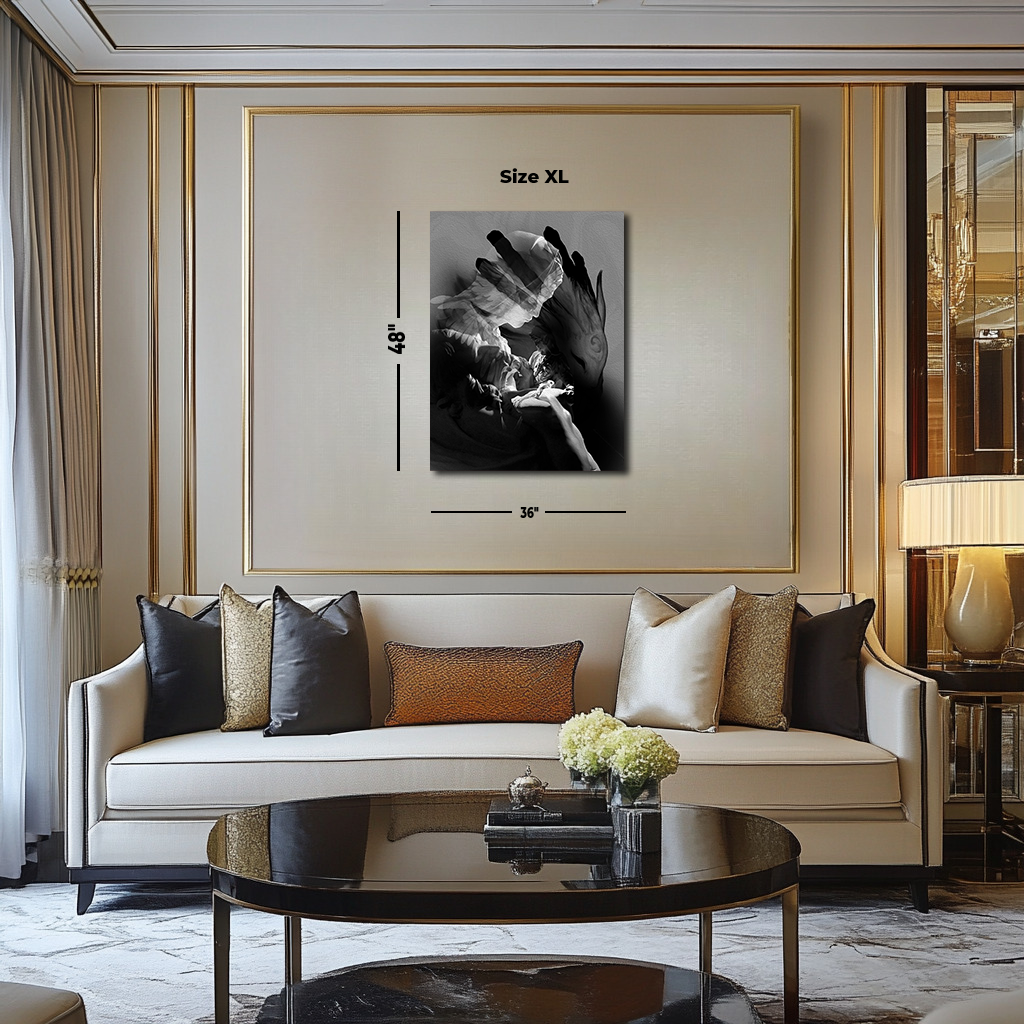Veils of Grace: A Conceptual Reimagining of Michelangelo’s Pietà
"Veils of Grace: A Conceptual Reimagining of Michelangelo’s Pietà " transforms the iconic Renaissance sculpture into a layered meditation on grief and grace. Through the interplay of monochromatic tones, angelic overlays, and abstract shadows, the work captures the dualities of loss and redemption, mortality and divinity. The Virgin Mary cradles Jesus with profound sorrow, illuminated by angelic wings that symbolize divine support. This contemporary reinterpretation preserves Michelangelo’s emotional core while expanding its narrative to reflect universal human experiences, making it a timeless exploration of love and transcendence.
Please see Below for Details…
Hotline Order:
Mon - Fri: 07AM - 06PM
404-872-4663
Michelangelo Buonarroti’s Pietà , completed in 1499 and housed in St. Peter’s Basilica, Vatican City, is one of the most celebrated sculptures of the Renaissance. It captures the Virgin Mary cradling the lifeless body of Jesus Christ in an expression of profound grief, love, and divine acceptance. This conceptual reimagining builds upon Michelangelo’s masterpiece, layering ethereal silhouettes, angelic forms, and chiaroscuro effects to transform the classical marble into an emotive dialogue about human fragility, spiritual transcendence, and the universality of mourning.
The original Pietà is a paragon of Renaissance naturalism, with its smooth marble surfaces and impeccable anatomical precision. In this reinterpretation, the sculpture’s contours are blended with translucent overlays of angelic wings and shadowy, enigmatic forms. The choice of monochromatic tones enhances the solemnity of the scene, inviting viewers to focus on the emotional depth rather than the physicality of the figures. The grayscale palette mirrors the timelessness of grief and the impartiality of death, creating a universal resonance.
The angelic presence, introduced as an abstract overlay, symbolizes divine grace and protection. These wings, softly merging with Mary’s figure, suggest that her sorrow is not solitary; it is shared and borne aloft by celestial forces. The incorporation of shadows around Jesus’ figure emphasizes his role as the bearer of human suffering, while the light illuminating Mary’s face conveys her simultaneous grief and acceptance. This interplay between light and shadow recalls Michelangelo’s original intent to depict a moment of profound spiritual significance while humanizing the divine.
The reimagined Pietà introduces a dynamic interplay between classical art and modern abstraction. The angelic forms, abstracted and fragmented, reflect humanity’s search for meaning in suffering. The swirling shadows and layered imagery suggest the turbulence of grief, while the light breaking through symbolizes the hope and redemption that follows. The inclusion of these surreal elements elevates the Pietà from a depiction of a singular biblical moment to a broader meditation on loss, love, and transcendence.
As an artist, the process of creating this reinterpretation was driven by a deep admiration for Michelangelo’s ability to fuse the divine and the human. The original Pietà captures the pinnacle of Renaissance artistry, but its emotional core transcends time. In this new version, I sought to honor that emotional depth while exploring the layers of grief and grace that resonate with contemporary audiences. The angelic presence was added to highlight the unseen forces of compassion and love that surround moments of loss, while the fragmented shadows reflect the fragmented nature of human experiences during grief.
The monochromatic color scheme enhances the sculpture’s emotive power. White and light grays represent purity, divinity, and hope, while the darker shades symbolize sorrow, mortality, and the unknown. This stark contrast mirrors the dichotomy of life and death, despair and faith, grounding the artwork in its spiritual themes. The choice to limit the palette also pays homage to the purity of Michelangelo’s original marble, reinforcing the continuity between the classical and the modern.
The emotional resonance of this conceptual collage lies in its ability to evoke both intimacy and universality. The Virgin Mary, though depicted in Renaissance attire, becomes an eternal symbol of maternal love and sorrow. Jesus, rendered lifeless yet luminous, reminds viewers of the fragility of life and the promise of redemption. The angelic forms, at once comforting and otherworldly, offer a sense of solace that transcends specific religious contexts, appealing to the universal human experience of loss.
The Pietà is a masterpiece of balance, symmetry, and emotion, and this reinterpretation seeks to preserve those qualities while expanding its narrative. By blending classical and contemporary elements, it transforms the scene into a meditation on the cyclical nature of grief and grace, loss and redemption. It invites viewers to reflect on their own experiences of mourning and the unseen forces of love and hope that guide them through.
Add your review
Your email address will not be published. Required fields are marked *
Please login to write review!
Looks like there are no reviews yet.










